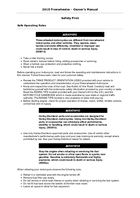Do not store motorcycle with gasoline in tank within the
home or garage where open flames, pilot lights, sparks or
electric motors are present. Gasoline is extremely
flammable and highly explosive, which could result in
death or serious injury. (00003a)
Engine exhaust from this product contains chemicals
known to the State of California to cause cancer, and birth
defects or other reproductive harm. (00004f)
Do not run motorcycle in a closed garage or confined area.
Inhaling motorcycle exhaust, which contains poisonous
carbon monoxide gas, could result in death or serious
injury. (00005a)
A new motorcycle must be operated according to the special break in procedure. See
Break in Riding Rules.
Operate motorcycle only at moderate speed and out of traffic until you have become
thoroughly familiar with its operation and handling characteristics under all conditions.
NOTE:
Harley Davidson recommends that you obtain information and formal training in the correct
motorcycle riding technique. In the United States, the Motorcycle Safety Foundation
®
offers
beginning, advanced and 3 wheel basic rider safety courses. Call 800 446 9227 for information.
Travel at speeds appropriate for road and conditions and
never travel faster than posted speed limit. Excessive
speed can cause loss of vehicle control, which could
result in death or serious injury. (00008a)
Do not exceed the legal speed limit or drive too fast for existing conditions. Always reduce
speed when poor driving conditions exist. High speed increases the influence of any other
condition affecting stability and increases the possibility of loss of control.
Steering and handling characteristics for a three wheeled motorcycle are different than a two
wheeled motorcycle. Approach corners and sharp turns using the appropriate speed and
steering technique to handle the turn and prevent rollover.
Pay strict attention to road surfaces and wind conditions, and always keep both hands on
the handlebar grips when riding the motorcycle. The vehicle may be subject to upsetting
forces such as wind blasts from passing trucks, holes in the pavement, rough road surfaces
and rider control error. These forces may influence the handling characteristics of your
motorcycle. If you experience these conditions, reduce speed and guide the motorcycle with
a relaxed grip to a controlled condition. Do not brake abruptly or force the handlebar. This
may aggravate an unstable condition.
The rear of the vehicle is wider than a typical motorcycle. Check for proper clearance when
maneuvering, cornering, parking and operating the vehicle in reverse.
Keep cargo weight concentrated close to the motorcycle and as low as possible to minimize
the change in the motorcycle's center of gravity. Distribute weight evenly on both sides of
the vehicle. Do not load bulky items too far behind the rider or add weight to the handlebars
or front forks. Do not exceed maximum specified load in Tour Pak or trunk.
NOTE:
New riders should gain experience under various conditions while riding at moderate speeds.



















































































































































































